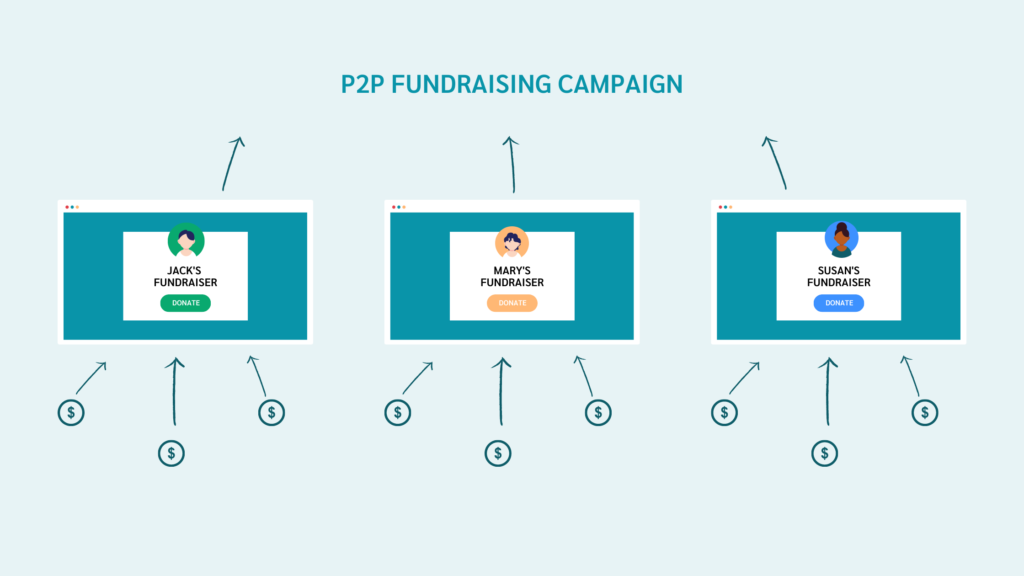17 Dec

The power of P2P Fundraising
How P2P fundraising has changed the game for nonprofits, civic organizations, and individuals looking to make a difference
Anyone who has worked as an advocate, nonprofit professional, or civic organization employee knows that questions and concerns around funding dominate everyday conversations and duties in the office. Since civic and nonprofit organizations are entirely dependent on either government funding or private contributions or donations, finding ways to tap new avenues of funding can be as important as the actual causes and initiatives that an organization is working toward.
The unfortunate truth to this structure is that for many nonprofit and civic organizations, the focus on fundraising can lead to spending more time securing funds than actually affecting change. This can be demoralizing, especially for young and idealistic employees – you signed up ready to trade long-term wealth for a meaningful career, and yet you are consumed with the same types of pitch meetings and promotional campaigns that you expected to leave behind in the corporate world.
Enter P2P fundraising. Short for peer-to-peer, P2P fundraising has proven to be a disruptive force for traditional nonprofit and civic organizations – and opened a whole new world of possibilities for pairing motivated and caring individuals with causes and initiatives they want to support. But how does P2P fundraising work? What benefits does P2P fundraising offer? Let’s take a deeper dive into this emerging new opportunity that is transforming the nonprofit and civic spaces.
How does P2P fundraising work?
- First, a nonprofit creates a fundraising campaign using their online fundraising platform (or an external platform). Similar to any campaign, this usually involves identifying a problem, proposing an advocacy or potential solution, and then informing potential donors how their support would help.
- Second, the nonprofit launches its campaign by inviting its supporters to customize individual fundraising pages within the platform. Their supporters then leverage their social networks to spread the word about the nonprofit P2P fundraiser – which hopefully leads to their networks producing supporters or subscribers.
- Each supporter’s fundraising page is also connected to the nonprofit’s main fundraising campaign page, creating a visible “movement” as more and more peers join the campaign and begin to support it.
- The makeup of the campaign page is entirely up to the nonprofit or civic organization, but common elements include a goal progress bar, a dynamic list of supporters who are fundraising on behalf of the organization or have pledged support, background information on the campaign and progress or news updates, and naturally a donate button to encourage new members to join.

What are the benefits of P2P fundraising (compared to traditional methods)?
Some of the benefits of the P2P fundraising model are fairly obvious, but there are some others that are subtly just as important:
- The ability to create, track, easily communicate with, and leverage your supporter base – both for the current campaign and any future campaigns.
- Campaign pages allow supporters to better stay connected with the power of their support, track progress of campaigns, and subsequently trust organizations more. People like to know how they made a difference or an impact, and things like the goal progress bar, list of supporters, or even social media integrations can better let supporters know how they made a difference (and make them more likely to support you in the future).
- Being able to “crowdsource” not only allows nonprofits to find alternatives to traditional philanthropic funding streams, but it also allows for a variety of creative fundraising ideas that wouldn’t have worked in traditional settings. This was especially important during the height of the COVID-19 pandemic, when organizations could no longer hold the galas and auctions that usually make up large parts of organizational revenue.
- P2P fundraising also benefits philanthropic-minded individuals, who may want to support organizations but would rather “get in on the ground floor” then be a part of a much more established organization. Individuals can use P2P fundraising platforms to “shop” for organizations they want to support, and even create their own campaigns that can be linked to a particular organization.
- P2P fundraising platforms can be integrated with event websites, allowing you to couple the fundraising tools with online invitations, RSVPs, selling tickets to secondary events, or other event management functionality.
Types of events where P2P is particularly useful
- Project launches, new campaigns, or even debuting a new nonprofit or civic organization
- Major giving days (such as Giving Tuesday)
- Matching gift fundraisers
- Creative fundraisers, such as a Mud Run, Polar Bear plunge, dunking booth, etc.
- Organizational anniversary or “birthday” events
- Thons, from running to biking to dancing and everything in between
- In the case of disruptive global events, like the past two years







Adam Hausman